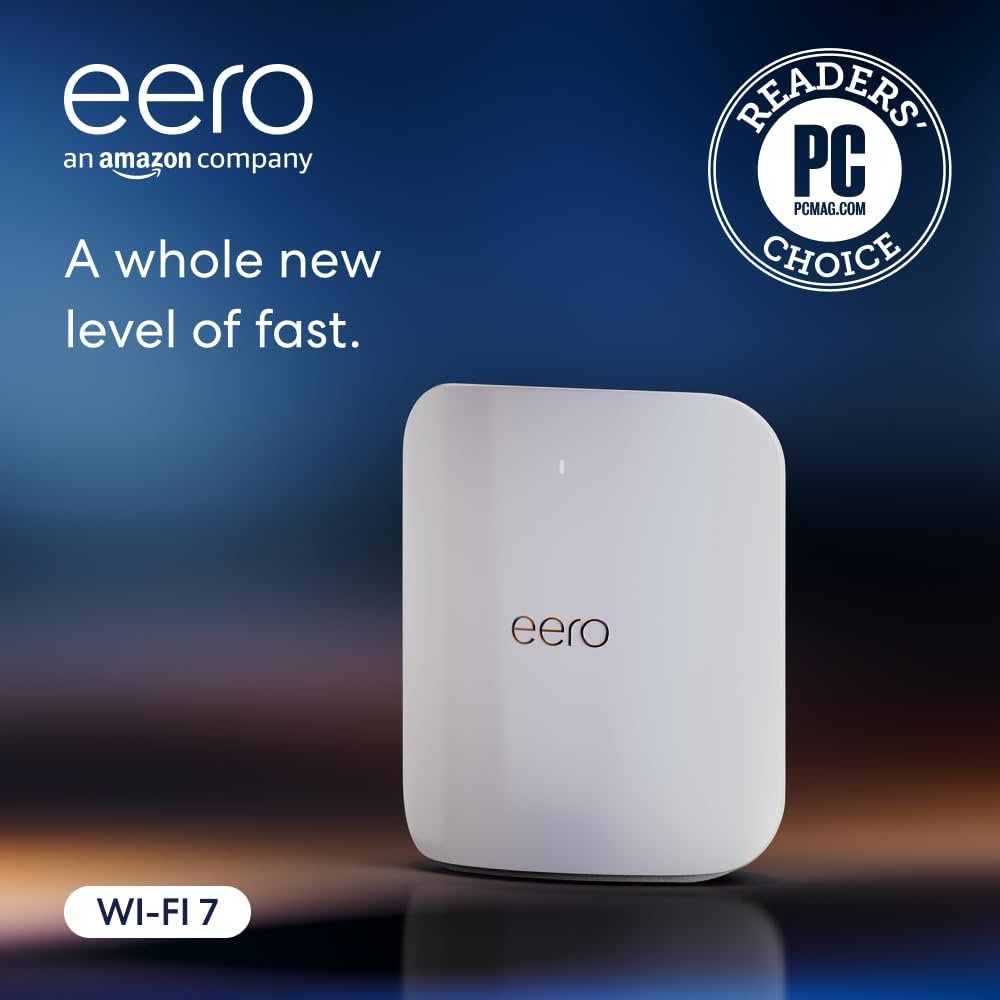Unleashing Speed: A Review of the Amazon eero Max 7 Mesh WiFi Router
- High-Speed Performance: Supports wired speeds up to 9.4 Gbps and wireless speeds up to 4.3 Gbps with two 10 Gigabit Ethernet ports.
- Wi-Fi 7 Technology: Offers more than double the speed of Wi-Fi 6, enhancing network capacity and reducing latency.
- Advanced Software Features: Includes patented TrueMesh technology for reliable connectivity and optimal performance.
- Gaming Optimization: Delivers high-performance experiences for gaming, AR, VR, and cloud applications requiring low latency.
- Enhanced Digital Security: Optional eero Plus subscription provides advanced protection for personal data and connected devices.
- Smart Home Integration: Functions as a smart home hub supporting Thread, Matter, and Zigbee devices.
- Extensive Coverage: Provides up to 2,500 sq. ft. of mesh Wi-Fi coverage and connects over 250 devices.
- Easy Setup and Management: Set up in minutes using the eero app, with a three-year warranty and dedicated support available.
Original price was: $599.99.$479.99Current price is: $479.99.
Exceptional Speed and Coverage
The Amazon eero Max 7 mesh Wi-Fi router truly elevates home internet experience to a new level. With its capability to support internet plans up to 10 Gbps and coverage extending to 2,500 sq. ft., this router delivers exceptional performance throughout my home. I’ve noticed a significant improvement in speed and reliability compared to my previous setup.
Wi-Fi 7 Technology at Its Best
The integration of Wi-Fi 7 technology is a game-changer. It provides more than double the speed of Wi-Fi 6, resulting in less latency and a smoother experience, particularly for high-bandwidth activities like gaming and streaming. Streaming 4K content and online gaming have never been better with virtually no lag.
Outstanding Connectivity
Connecting over 250 devices seamlessly is another highlight of the eero Max 7. In a household with multiple smart devices, this router handles it all without missing a beat. The patented TrueMesh software ensures that I remain connected to the optimal Wi-Fi signal, minimizing any interruptions.
Easy Setup and Management
The eero app is user-friendly and makes setting up the network a breeze. It walks you through the entire process, and I was able to manage my network effortlessly from my smartphone. Plus, the industry-leading three-year warranty gives me added peace of mind.
A Smart Investment for the Future
With an optional subscription to eero Plus, I feel secure knowing that my personal information and connected devices are protected from online threats. The eero Max 7 is not just a router; it’s a smart home hub that integrates well with various smart devices. Overall, this product is a robust and future-proof investment that meets and exceeds my expectations.
Specification: Unleashing Speed: A Review of the Amazon eero Max 7 Mesh WiFi Router
|

















DaKon –
I live in a long, two-story townhouse with a garage, which has a lot of solid barriers. I previously used Google Nest Wifi with four points, but I needed a system with at least 2.5 Gb Ethernet ports to match my internet speed. I opted for the two-pack, and it performs significantly better than my previous setup. Connections across all frequencies are stable and reliable, with no drops. The speed is impressive, and the software is user-friendly. I did have to reinstall the Eero app on my Android device to update the software on the Eero access point, but that was a minor issue.
The Real Deal Reviews with Jenny –
I’ve been using the Eero 7s in my home, and they are amazing! With three units covering our 5,200 square feet, the coverage is exceptional. A single router couldn’t meet our needs before, but now, with all three Eero 7s, I enjoy strong, reliable Wi-Fi throughout the whole house. Even when I step far outside, my tablet and cell phone still maintain a strong signal. I highly recommend them!
J. Washum –
I’ve been using the 3-node Eero 6 Mesh system since its release, about four years ago, and I’ve only encountered one issue, which Eero support handled brilliantly.
Having designed and built numerous nationwide networks since the mid-90s—ranging from small ISPs to corporate wireless systems—I enjoy tinkering with technology. However, I prefer not to spend my free time fine-tuning networks unless it’s work-related. I need a system that’s fast, stable, and secure without requiring constant adjustments.
The Eero 6 served me well, but as we added more devices and increased our bandwidth with more people working and gaming from home, it was time for an upgrade. I was initially hesitant about buying this system due to mixed reviews. I know that dissatisfied customers are more likely to leave feedback, and the ratings weren’t as high as my previous system. Still, I decided to try it, hoping to avoid ongoing issues.
I’m pleased to report that the setup was incredibly easy—possibly the easiest I’ve ever experienced. I simply unplugged my old system, connected the new primary device, and opened the app. It prompted me to replace the old system, which I did, and it configured everything using my previous settings in under 10 minutes, including a firmware update. Adding the secondary device took just a couple of minutes, and I removed the old extensions from the app without having to reconfigure any connected devices. This saved me a significant amount of time.
Currently, I have a 1 Gbps connection with plans to upgrade to 2 Gbps soon, and I feel confident that this system will handle it. My wireless speed in the studio room jumped from about 40 Mbps to a full gig, and the farthest room in the house, which previously relied on an extension, now gets 800 Mbps with just the two-device system. I even plugged our Apple TV directly into Ethernet in the den, eliminating occasional stutters while streaming 4K.
Our cable modem is standard for the area, and while I helped set it up in the 90s, I haven’t been involved in over two decades, so there’s nothing unique about our connection.
I’m using the free app, which has functioned perfectly for four years without the need for paid features. Most users will likely find the standard app sufficient.
My home is a single-story, 2600 sqft space. The gateway is located in the office at one end, and I placed the extension in the middle, providing complete coverage, even outdoors. While the system claims to cover 5000 sqft, I believe 3000 sqft is more accurate based on my experience. A single unit could easily cover around 2000 sqft if positioned centrally.
While these systems aren’t cheap, the upgrade was worth it for the speed and overall quality of life. I expect to enjoy more than four years of reliable service.
I’m very satisfied and highly recommend this system, especially for those with many devices in their homes. After three months, the system continues to perform flawlessly, with quick and stable updates.
HC –
The Eero 7 maintains the same simplicity and reliability as previous models while offering multi-gig LAN networking capabilities.
Recommendations:
My network setup and its results:Objective: Currently, I don’t need 10 Gbps, but I aim for bilateral 2.5 Gbps LAN, with the option to upgrade to 10 Gbps in the future if necessary.ISP status: My current service offers 1.4 Gbps, but two different ISPs are installing fiber in my neighborhood, both promising up to 10 Gbps bilateral service soon.Home challenges: I live in a large, three-story, 170-year-old granite home with plaster walls and a detached carriage barn. The layout includes many small rooms and WiFi-blocking barriers. I have existing Cat 5e cabling throughout, which can support multi-gig speeds over short distances, even though Cat 5e is rated for 1 Gbps beyond 30 feet. All my cable runs are under 20 feet.
Design architecture: The Eero 7 serves as my primary router, connecting one of its 10 Gbps ports to the ISP modem and the other to two 2.5 Gbps switches in the basement for Ethernet backhaul over Cat 5e cabling. I’ve linked five previously owned Eero Pro 6E access points to these switches via Ethernet, strategically placing them around my home and barn. I also have additional spare Ethernet LAN ports available.
Rationale and tradeoffs: The Eero 7 was crucial for enabling the multi-gig LAN since the Eero Pro 6E chipset limits one Ethernet port to 1 Gbps. I opted not to replace my five Eero Pro 6Es with Eero 7s due to the high cost and instead am utilizing the Eero 6Es as 2.5 Gbps Ethernet backhaul access points. I chose 2.5 Gbps switches over 10 Gbps switches to save about $400, resulting in a total expenditure of $1,000 for the two switches and one Eero 7.
Results: My 5 GHz wireless clients achieve 650 Mbps without any distance-related degradation in every room. Devices seamlessly switch between access points as I move around. My WiFi 6E clients on a 1.4 Gbps ISP connection pull 1.3 Gbps within 10-15 feet of each access point. All wired Ethernet ports maintain a steady 1.34 Gbps from the internet. Although I haven’t measured the internal LAN speed, the switch indicator lights confirm a 2.5 Gbps connection to each Eero Pro 6E access point. My 4K TVs perform excellently, and my 14-device wireless SONOS system operates flawlessly without drops. All devices connected via 5 GHz report no connection issues. I’ve successfully managed five simultaneous teleconferences, some broadcasting in 4K without glitches.
Future plans: I intend to upgrade my ISP connection to either 2 or 5 Gbps once the fiber infrastructure is completed and will retest speeds. If I decide to game, I’ll switch to a 10 Gbps connection, placing one 10 Gbps switch on the Eero 7’s outbound port and connecting my gaming console along with the basement switches. I don’t see the need to upgrade the remaining Eero Pro 6E access points until WiFi 7 devices become commonly used and applications requiring 3-10 Gbps arise.